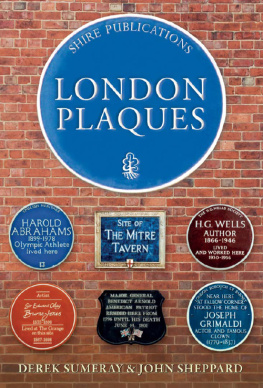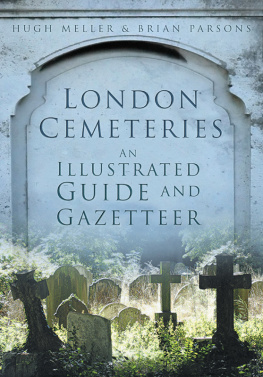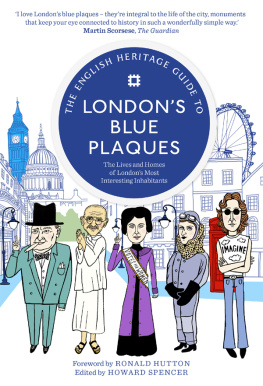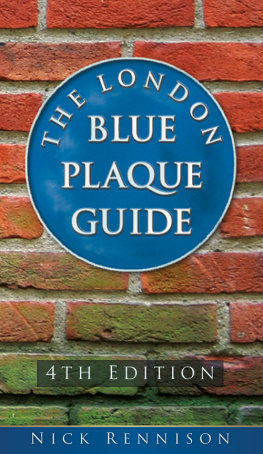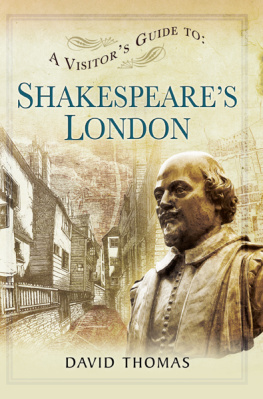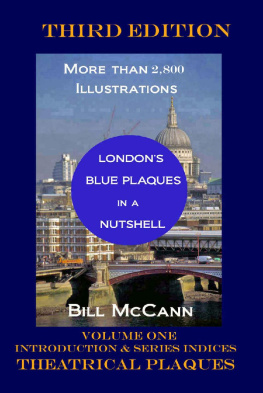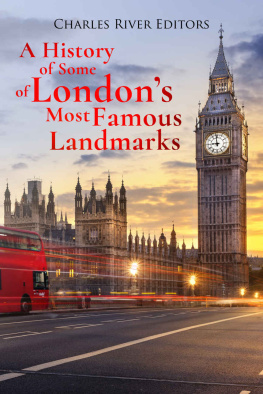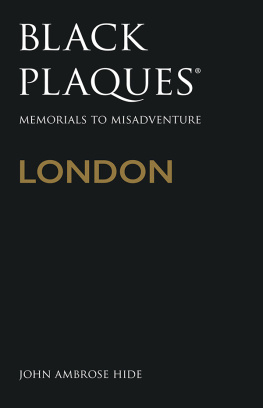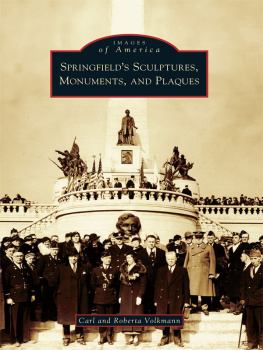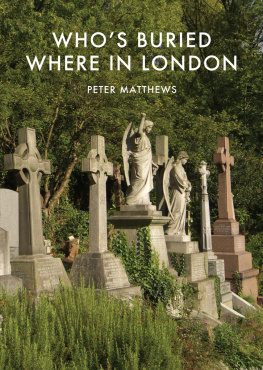LONDON PLAQUES
Derek Sumeray and John Sheppard
SHIRE PUBLICATIONS
CONTENTS
Westminster 4:
INTRODUCTION
T HIS BOOK contains entries for just over 1,800 plaques across the metropolis. It is the most comprehensive gazetteer available, aspiring to, but not claiming, completeness. It amounts to a collage history of London, each entry a keystroke confirming the unrivalled depth and variety of Londons past. In these pages scientists jostle with cricketers, long-gone tollgates with vanished churches, physicians with novelists, botanists with composers, reformers with reactionaries, VCs with suffragettes each contributing a residual vibration to the ensemble. Taken together, these plaques are a chorus, belting out a confirmation that London is the greatest city on earth.
Derek Sumeray (19332003) was the original begetter of this book in 1999 and the majority of the contents remains his. He had been a successful manufacturer of jewellery, with a custom-built factory in Milton Keynes, but, having sold the business, he turned to indulging his hobby of photography, and in particular to documenting the plaques of his native London. His widow estimates he devoted five years to the initial trawl, along with countless days in the British Museum Newspaper Library at Colindale. The effort, in pre-internet times, is awesome. Just as The Buildings of England series is known in short as Pevsner, in tribute to its founder and original author, so should London Plaques, whoever comes along to do further revisions in another ten years time, forever be known as Sumeray.
Due tribute to Derek Sumeray having been paid, we have thought it right to make some alterations in the structure and remit of the book. He styled the collection A Guide to Commemorative Plaques within the M25, whereas we have preferred to make our boundary Greater London. This means farewell, for example, to the vigorous programme of plaque erection carried out by Loughton Town Council in Essex, such as those illustrated below.
Similarly, other plaques within the M25, but in Surrey or Hertfordshire, have gone.
Another fundamental change from Derek Sumerays first edition is that we have divided the entries by borough; it is thought the book will be more useful for a reader out walking if the plaques of particular areas are grouped together. Otherwise, the criteria remain the same: the plaque must be exterior and readily visible to a passer-by, and it must evoke something historic about the place of its erection words like was born here, lived here, died here, in a house on this site and near this spot mean that as you read the plaque you are invited to summon to mind a presence from the past right where you are standing. So, for example, a plaque which simply said This is an eighteenth-century warehouse would not qualify, but if it said This is an eighteenth-century warehouse where Lord Greymatter conducted experiments with early hydraulic lifts it would be included. Even with these restrictions, Derek Sumeray mustered some fourteen hundred plaques in 1999, a total now swollen by well over four hundred additions ten years later.
The first mention of memorial plaques came in the House of Commons on Friday 17 July 1863, when William Ewart (q.v.), the reforming Liberal MP for Dumfries, rose to ask:
whether, through the agency of the Metropolitan Board of Works, it may be practicable to have inscribed on those houses in London which have been inhabited by celebrated persons, the names of such persons. The places which have been the residences of the ornaments of their history could not but be precious to all thinking Englishmen and when he reminded the House how rich the metropolis was in such associations, he thought they would agree with him that it was desirable some record should be placed upon the respective localities.
In the event, the Metropolitan Board of Works was not to be the agency, but, after further discussions in The Builder and in The Journal of the Royal Society of Arts, it was the RSA that undertook the scheme, putting up its first plaque, to Lord Byron, in Holles Street, W1, in 1867. That plaque does not survive, but sixteen of the thirty-five erected by the RSA do. In 1901 the scheme was taken over by the London County Council, and 253 of its plaques are recorded here. The LCC was replaced by the Greater London Council in 1965 and from its twenty-year management we find 246 plaques surviving. Then, in 1985, when Mrs Thatcher temporarily dispatched London local government to oblivion, the baton passed to English Heritage, which to date has put up 309, while also taking responsibility for the conservation of its predecessors plaques. This continuous strand, from the Royal Society of Arts to English Heritage, has produced 824 surviving plaques, over 40 per cent of the total recorded here. Many people casually think English Heritage is responsible for all plaques in London, but there are numerous other schemes, most notably those of the City Corporation and the City of Westminster. And, aside from formally organised programmes, there are 271 plaques recorded here that have been privately erected; indeed anyone may put up a plaque anywhere, so long as they have the building owners permission and, where necessary, Listed Building consent.
Briefly to continue the statistical vein, the man with the most plaques in his honour is Charles Dickens, who musters ten. The silver medal goes to William Morris, with eight, and the bronze to William Wilberforce with seven. Tied for fourth place are Charles Lamb and George Orwell, with six plaques each, followed by a veritable pile-up of notables with four or five plaques each, including Churchill and Chaplin, Dr Johnson and Pepys, along with the most-plaqued females, Sylvia Pankhurst and Jacqueline Du Pr. Men outnumber women by roughly seven to one, and the English outnumber the next largest nationality by roughly fifteen to one. The other nations most represented are the Scots, Irish, Americans, French, Germans and Welsh.
Any claim to completeness in a guide such as this would be the height of folly. In the ten months that I have worked on this revision, nineteen further plaques have been put up that I know about. I feel sure there have been more, just as I feel sure there are many more that have been up for years undiscovered by Derek Sumeray or me. Similarly, there will be plaques recorded here that have regrettably been removed. Shire Publications will be maintaining an open file in anticipation of a third edition in some years time and will be grateful to receive information on any new plaques going up, and indeed corrections to any mistakes that surely lurk, despite my best efforts, herein. All suggestions, additions, deletions and amendments should be sent to
This is one of those books where the index is a major contribution to the fun; I commend to you any list that throws up shoulder to shoulder partnerships such as Captain Cook and Peter Cook, Jimi Hendrix and Henry VIII, Bobby and Henry Moore, Bob Hope and Gerard Manley Hopkins, Joe Orton and George Orwell, Monty Python and Queen Mary, Madame Tussaud and Mark Twain, Johann Zoffany and mile Zola. There are bogus plaques, spoof plaques, inaccurate plaques, and there is a plaque to a cat overall a pot-pourri that surely no other city in the world could muster.
In preparing this revised edition I have been greatly helped by local archives and local history societies, too numerous to mention individually, but to them all a collective heartfelt thank-you. To my editor at Shire, Nick Wright, particular gratitude for thinking I could do the job and then for keeping me on the straight and narrow while doing it. Finally, to my wife, Olga, who has tolerated my hogging the computer, sorted out various computer mysteries for me, and chauffeured me on several photographic forays, my love and thanks.

